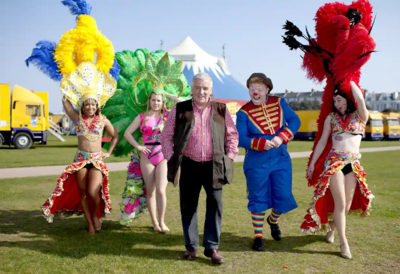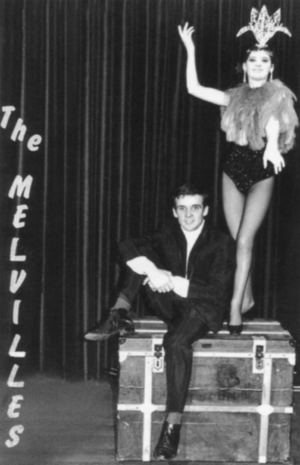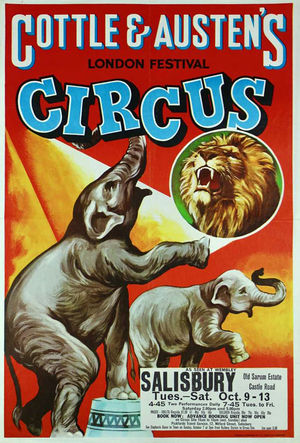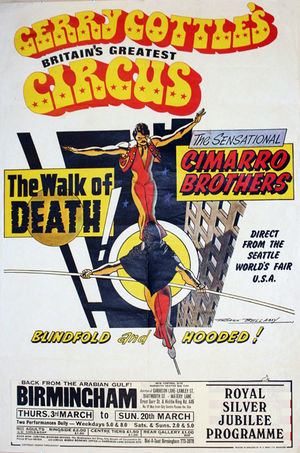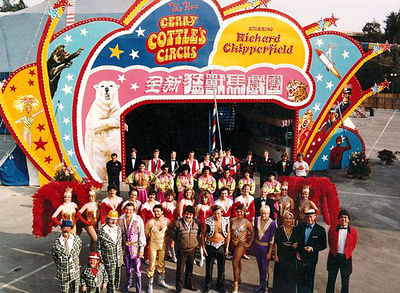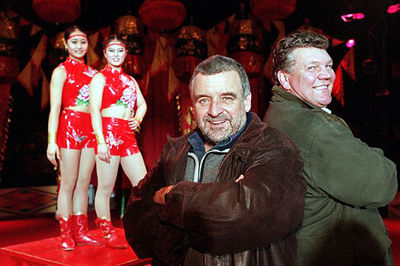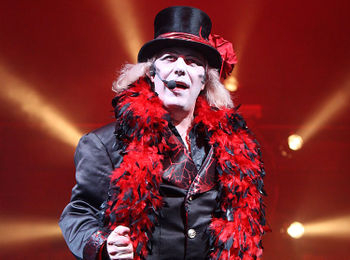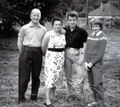Gerry Cottle
From Circopedia
Circus Owner and Producer
By Dominique Jando
When Gerry Cottle (1945-2021) opened his first circus in 1970, two of Britain’s three major circuses, Bertram Mills and Billy Smart, had folded their tents, and the third, Chipperfield, had become but a pale shadow of its former self. The great British circus impresarios of the post-WWII era, Cyril and Bernard Mills, Billy Smart, Jimmy Chipperfield, and Tom Arnold had left the stage and there was indeed a huge void to fill. The ambitious and gifted Gerry Cottle seized the opportunity, and his name soon became synonymous with "circus" in the United Kingdom and would remain so until Cottle’s untimely death in 2021.
Gerry Melville, The Teenage Juggler
He was born Gerald Ward Cottle on April 7, 1945 in Carshalton, in the London borough of Sutton, to a family that had no relation with the circus or, for that matter, with show business: His father, Reg, worked as a stockbroker in the City, and his mother, Joan, née Ward, was a former flight attendant; he had a sister, Jane. His was a good middle class, white collar family, and little Gerry was expected to follow in his parents’ footsteps. Unfortunately—or fortunately—they took him when he was eight-year-old to Jack Hylton’s Circus at Earls Court, in London. He caught the circus bug and, then and there, decided that he would become not a clownGeneric term for all clowns and augustes. '''Specific:''' In Europe, the elegant, whiteface character who plays the role of the straight man to the Auguste in a clown team., an animal trainer, a juggler or an acrobat, but simply a circus director—and this idea would never leave him.Gerry Cottle grew up at a time when the British circus was in its most glorious period: Billy Smart’s and the Chipperfields’ circuses were among the largest in Europe, and the Mills brothers had successfully maintained the highest standards of excellence that their father, Bertram Mills, had set for his circus long before the war. For the Christmas season, Londoners had a choice between three circus spectaculars: Jack Hylton’s at the Earls Court arena; a massive circus show produced by Tom Arnold at the Harringay arena; and, since 1920, the highly respected Bertram Mills Circus, which presented one of Europe’s most acclaimed shows at London’s Olympia—the quality and perfection of which fascinated the young Gerry Cottle.
Gerry also visited traveling shows when he was vacationing with his family in Cornwall, and he was a frequent guest of the Chessington Zoo in Surrey, which always presented a small circus (staged at the time by the Paulo-Thompson family) where young Gerry often helped groom the horses. Circus had become such an obsession that in 1960, at age fifteen Gerry Cottle left his home and took a train to Newcastle, where he joined Robert Brothers Circus. He had left a message to his parents: "Please do not under any circumstances try to find me. I have gone for ever. I have joined the circus. You do not understand me. You are not listening to me. I do not need O-levels where I am going. I am going to join the circus. I have gone." He was back home two weeks later.Gerry was a very imaginative and restless kid whose academic achievements at school were far from brilliant. His parents eventually cave in and let him go and fend for himself in the circus world. Gerry returned to Robert Brothers Circus and began to work in a variety of menial jobs at the very bottom of the ladder. It was a hard but efficient way to learn the inner workings of a traveling circus, and this apprenticeship would later serve him well. He then went to Joe Gandey’s Circus, where he tried his hand at performing (as a stilt walker, on the rola-bolaA board balancing on one or more cylinders piled on each other, and on which an acrobat stands performing juggling or acrobatic tricks., as a clownGeneric term for all clowns and augustes. '''Specific:''' In Europe, the elegant, whiteface character who plays the role of the straight man to the Auguste in a clown team.…), although circus chronicler Don Stacey, who saw him in these early experiments, noted that “he was not especially adept” at any of these endeavors. He eventually built a juggling act, which he titled "Gerry Melville, The Teenage Juggler."
During these formative years, Gerry expanded his apprenticeship in a variety of occupations—in circuses, but also on tour with Kirby’s Flying Ballets’ production of Peter Pan in the United Kingdom and with Holiday On Ice on the continent, or on the set of the movie The Evil of Frankenstein (1964, starring Peter Cushing), where he met and struck a long-lasting friendship with Brian Austen. Austen, like him, had joined the circus when he was fifteen and had learned the tools of the trade the hard way. Then Gerry Cottle-Melville joined Jim Fossett’s James Brothers Circus, where he fell in love with the director's daughter, Betty Fossett; they were married in December of 1968.
Together, Gerry and Betty developed a new act titled "The Juggling Melvilles, Aristocrats of Balance" (in which Gerry displayed his skills as a juggler and on the rola-bolaA board balancing on one or more cylinders piled on each other, and on which an acrobat stands performing juggling or acrobatic tricks. while Betty looked pretty), and then a magic act in which he and Betty performed Houdini’s classic substitution-trunk illusion, Metamorphosis. They also appeared with their acts in pantomimes. Gerry’s performing career was slightly improving, but his original dream had not disappeared: He was more than ever intent on becoming a circus owner.
Enter Brian Austen
At the James Brothers Circus, Gerry reunited with his friend Brian Austen, who was performing in the show with his girlfriend. As far as their passion for the circus went, Gerry and Brian were very similar, but they differed in many other ways. Gerry was a gambler, a congenial extrovert who had the makings of a true showman, knowing how to generate publicity and put himself at the center of attention—whereas Brian, who was two years Gerry’s junior and came from a poor working class background, was shy and discreet and preferred to remain in the shadows. Yet, Brian had a strong entrepreneurial drive, but he was also pragmatic and financially conservative, and he understood well the logistics and technical aspects of the circus. Gerry Cottle and Brian Austen actually complemented each other well.
The first circus Austen had joined was a deteriorating outfit pompously titled Count Lazard’s Anglo-American Circus, with which he eventually landed in South Africa. Once there, the Count discovered that his promoter had vanished. After a rude apprenticeship in circus survival, during which the resourceful Brian helped in no small part the Anglo-American regain its footing, he left the Count and his circus, and returned to Britain with his new girlfriend, Mavis, who was Count Lazard’s sister-in-law... The experience had served him well: Brian had learned during his adventure with Count Lazard what you shouldn’t do if you wanted to run a circus successfully.It is probably Brian who spotted the crumbling Embassy Circus: He knew all too well when a failing circus was reaching the end of its rope. He and Gerry joined forces and acquired what was left of it in 1970. With Brian’s technical know-how and Gerry’s flair for publicity, they quickly put the enterprise back on its feet and changed its name to Cottle & Austen Circus. They opened their new show on July 6, 1970 in the small town of Sturminster Newton in Dorset, in the southeast of England. Gerry Cottle was finally what he had always wanted to be: A circus owner.
At the beginning, Gerry, Brian, his girlfriend, and Betty provided most of the show contents with their panoply of acts. Four years later, however, Cottle & Austen Circus had become Britain’s premier circus. They had had a big break when Cottle & Austen was featured in the BBC documentary series The Philpott Files in 1971, which in turn led it to appear on the cover of the Radio Times magazine under the title: "The smallest Greatest Show on Earth." Then Gerry’s decision to play London’s parks—something no circus had done in years—further contributed to put Cottle & Austen Circus in the spotlight. There was another factor to their success, though: As Brian Austen put it, "We never had a brilliant circus, but we had an entertaining circus. We put it together well and made it gel."
At a time when British circus owners operated for the most part in a basic survival mode, paying little attention to their patrons’ comfort and the looks of their equipment, Gerry and Brian insisted in the cleanliness of their trucks and wagons, which were uniformly painted in a bright blue, yellow and red livery and were proudly displayed in front of a neat, large blue tent: Following the examples of Billy Smart and Bertram Mills before them, they wanted to give their potential customers a positive first impression.
However, Gerry Cottle was as restive as ever; inspired by the success of their circus, the reckless gambler in him decided to launch a second traveling show named Carnival on Ice. He did it against Austen’s better judgement and the enterprise proved a financial failure. Gerry and Brian had obviously diverging ideas with regard to the growth of their enterprise. In July 1974, they chose to part company amicably. Gerry created the Gerry Cottle’s Circus, while Brian went on with his Austen Brothers Circus.
Gerry Cottle’s Circuses
Although both circuses were successful, Gerry Cottle, always the showman, managed to quickly turn the spotlight onto himself; all opportunities were good for a photo-op: He created news when he had his children baptized under the big topThe circus tent. America: The main tent of a traveling circus, where the show is performed, as opposed to the other tops. (French, Russian: Chapiteau), and in 1976, he built what he boasted to be the world’s largest live-in caravan: Fifty-five feet long (16,5 meters), with seven rooms! He also established a relationship with the BBC and, from 1975 to 1978, his circus became the scene of their popular summer television show, Seaside Special. Additionally, Gerry made several guest appearances on BBC major variety shows. All this gave the Gerry Cottle’s Circus national exposure and made Gerry’s a household name that soon became synonymous with circus.In spite of his success, or perhaps because of it, Gerry ‘s insatiable imagination and drive pushed him to constantly create something new, and whereas Brian Austen wisely used his circus profits to diversify his investments—which would make him a rich man indeed—Gerry Cottle embarked in a frenzy of new circus ventures, sometimes with the financial help of his former partner or in association with him. Some were very successful, others lasted just the time to pronounce their names! In the process, the adventurous Gerry would make and lose fortunes.
It would be tedious to tell the story of each of his creations, especially considering their long list: Gerry Glitter’s Rock & Roll Circus, Zincalli Gipsy Circus, The Rainbow Circus, The Florida Shark Show, Cottle & Austen Electric Circus, Continental Circus Berlin, Mary Chipperfield’s Circus, Gerry Cottle’s Xanadu, Cottle Sisters’ Circus, Cottle’s Daredevil Circus, Circus Ethiopia, Wow! (a stage show), Zambesi Express, Gerry Cottle’s Turbo Circus, Gerry Cottle’s Wow Circus, The Magic Circus... His most successful ventures, which deserve more than a mention, were The Circus of Horrors, which he created with John Haze, and the Moscow State Circus and the Chinese State Circus, created in association with Brian Austen.
Yet, there was another venture that is often overlooked and, although short-lived, was successful in its purpose: Gerry Cottle’s Circus School. It was created in 1984, at a time when circus schools were beginning to pop up everywhere in Western Europe (the first of which had been created in Paris in 1974 on the Russian model), and immediately attracted young people who didn’t belong to the still very secluded circus world and wanted to embrace a circus career.
Two years later, in 1986, one of the school’s acts, The Andrews (Andrew Watson and Jacqueline Williams), who performed a romantic trapeze duet, won a Bronze Medal at the Festival Mondial du Cirque de Demain in Paris. Afterwards, The Andrews enjoyed a successful international career and Andrew Watson eventually became an Artistic Director at Cirque du Soleil. With his circus school, Gerry Cottle had proved to be a visionary and a pioneer, and one can only regret that this early experiment, which predated London’s Circus Space (today London’s National Centre for Circus Arts), didn’t last longer.At that time, however (in the 1980s), Gerry Cottle was particularly busy: From the late seventies through the eighties, he took his circus to the Middle and Far East, visiting, Oman, the Emirates, Hon-Kong, China, Malaysia, and Singapore; closer to home, he also visited Ireland, and, in 1990, The Netherlands—a visit heralded as the beginning of a European tour that never materialized (and was probably just good circus ballyhoo). These tours, however, were not always rewarding. In 1979, he decided to take his circus to Iran; he had boarded all the artists booked for the occasion and all his circus equipment on cargo ships, when he learned the Iranian Revolution had started! His producer, an Iranian general, had not yet paid the contractual deposit and vanished in the turmoil; left penniless with mounting debts, Cottle was obliged to declare bankruptcy.
From the Moscow State Circus to Circus of Horrors
In 1991, the Soviet Union was collapsing, and numerous Russian artists and newly formed independent circus companies (as well as SoyuzGosTsirk, the old Soviet State Circus company), were approaching Western producers to tour their shows out of Russia. Gerry Cottle and Brian Austen joined forces once more and jumped on the opportunity; they created their long-lasting Moscow State Circus. The show, composed entirely of imported Russian acts, has proved very successful and, with regularly renewed programs, has toured the U.K. under the big topThe circus tent. America: The main tent of a traveling circus, where the show is performed, as opposed to the other tops. (French, Russian: Chapiteau) up to this day (2021).At the same time, Gerry Cottle's Circus was expanding its activities: For the Christmas season 1992-93, following in Bertram Mills's and Tom Armold's footsteps, Gerry presented a circus spectacular at Wembley in London, and at the same time, had his Gerry Cottle's Circus under the big topThe circus tent. America: The main tent of a traveling circus, where the show is performed, as opposed to the other tops. (French, Russian: Chapiteau) offering another show at Battersea Park. Gerry was the first showman who had two circuses playing simultaneously in London!
Then, banking on this success, Gerry and Brian decided to do the same thing with Chinese acrobats, who were performing increasingly in the West, and they reached out to Philip Gandey, who had contacts with Chinese acrobatic troupes. The Chinese State Circus was born in 2000 and became as successful as its Russian counterpart (it is today run by Philip Gandey’s organization). Both shows were presented under state-of-the-art big tops, with comfortable seating and all the amenities of a regular theater—something that was not seen too often in Britain.
Another of Gerry’s very successful enterprises came from an encounter with rock singer John Haze, better known as "Dr. Haze." Although Haze’s father didn’t come from a circus background, he had been a bear trainer, and John was born in the circus—but his father quickly abandoned mother and son, and Haze spent his first ten years with his grandmother in Lancashire. He had "sawdust in his veins," though, and when his father reappeared after a sojourn in prison, the family went to work in a small circus in Ireland, where John became a fire eater and the circus version of a young fakir.His father made another flit and his mother left the circus for good, but John remained a circus performer—until he decided to become a rock singer and create a band, which he did when he was twenty. The band was first called Flash Harry and soon adopted a better name, Haze. Then, in 1991, visually inspired by the likes of Alice Cooper and by the movie The Exorcist (1973), and building on his circus experience, Haze’s stage show became The Circus of Horrors, which mixed rock-n-roll and circus acts in a goth and sometimes gory atmosphere.
Haze met Gerry Cottle in 1994 at the funeral of Haze’s godson, Neville Campbell, who had fallen to his death at Blackpool’s Tower Circus while performing a "wheel of death" act. Campbell had been a close friend of Gerry’s son, Gerry, Jr. Haze then told Gerry that he wanted to expand his Circus of Horrors show into a true circus show under a big topThe circus tent. America: The main tent of a traveling circus, where the show is performed, as opposed to the other tops. (French, Russian: Chapiteau). Gerry Cottle, always on the look for a new adventure, thought it was a good idea, and soon after, The Circus of Horrors as it is known today (2021) all over Britain and beyond, was born. With Gerry’s name, his showmanship and sense of publicity combined with John Haze’s artistic vision, the hitherto little-known Circus of Horrors show became an immediate sensation and an unmitigated success.
A Chaotic Life
Gerry Cottle was a man of great charm and, for all his fame and glory, of great simplicity. He had numerous extra-marital affairs and he and Betty eventually separated in the 1990s, but they never divorced. (Together, they had had four children, Sarah, April, Juliette-Anne, known as Polly, and Gerry Jr.) Gerry had a long relationship with Anna Carter, the co-founder of Carters Steam Fair (a small traveling funfair with vintage restored carrousels and attractions), but he had many other girlfriends. In 1983, one of them introduced him to cocaine: It was the beginning of a long addiction that may explain his creative frenzy and recklessness. In 1991, Gerry was arrested for substance possession, fined, and jailed for a short time. This finally led him to give up drugs definitely.His businesses suffered indeed greatly from his habit. Then, in 1994, he had to declare bankruptcy (for the second time) after being sentenced for tax evasion. By then, he had become convinced that circus with wild animals in Britain had no future: Constantly badgered by animal activists, he had sold his last elephant in 1993, and the Circus of Horrors project gave him the welcome possibility to go in a different direction—although he will always remain a staunch defender of classical circus.
Finally, in 2003, he decided to leave the circus for good. He sold his interests in the Moscow State Circus and the Chinese State Circus to Brian Austen, his interest in the Circus of Horrors to John Haze (whom he had involved in other projects, such as Continental Circus Berlin, which Haze now owns), and disposed of all his other circus interests and possessions in order to raise money and build an antique center in Addlestone, Surrey—but he failed to obtain a planning permit and lost £30,000 in the venture. Of course, this was not enough to discourage Gerry Cottle: His next move was to buy Wookey Hole Caves.
Wookey Hole Caves, an ensemble of subterranean limestone grottoes, were just a popular attraction(Russian) A circus act that can occupy up to the entire second half of a circus performance. in Somerset, in the southwest of England. Over the years, Gerry, always the showman, developed them into a major tourist attraction(Russian) A circus act that can occupy up to the entire second half of a circus performance., surrounding them with hotel and restaurants, a "Valley of the Dinosaurs" with animatronics, a miniature golf, a "Mystic Fairy Garden," and a host of other attractions (including the reintroduction of the Wookey Hole cave-aged cheddar!). True to his first love, Gerry Cottle added to the mix a circus school whose students give regular circus performances to the visitors.
Epilogue
A very successful venture, Wookey Hole Caves will be Gerry Cottle’s lasting legacy. Yet, he couldn’t really put his hands off the circus: Beside his circus-cum-school at Wookey Hole, he launched a new show, Wow Circus, which he took on the road with his three daughters (his son had left the circus; he became a movie exhibitor and created the very successful Rooftop Cinema Club). Wow Circus was not a resounding success and didn’t last very long. It could have been yet another bump in Gerry's long career, but not a financial catastrophe: At long last, like his friend Brian Austen, he had diversified his investments and was finally racking up the benefits of his Somerset venture.
In 2006, Gerry published his memoirs, Confessions of a Showman – My life in the Circus, in which he was quite candid about his private life and his drug addiction. One wonders what else Gerry Cottle, the ultimate showman, would have created had the Coronavirus pandemic not hit the planet in 2020: Gerry Cottle, who was battling prostate cancer, died of Covid-19 in Bath, twenty miles away from Wookey Hole, on January 13, 2021. He had seven grndchildren and two great-grandchildren. His passing was widely acknowledged by the British media, which recalled at length Gerry’s colorful career, his many achievements, and saluted in him Britain’s greatest showman—which indeed he had had been.
Suggested Reading
- Gerry Cottle, with Helen Batten, Confessions of a Showman – My life in the Circus (London, Vision, 2006) — ISBN 978-1-904132-85-5
See Also
- Video: Ringside at Gerry Cottle's Circus, BBC documentary (1992)
